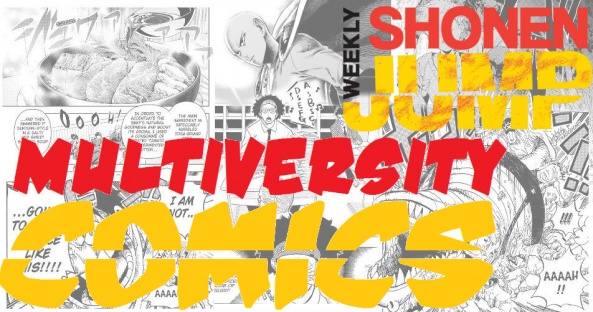
Welcome to This Week in Shonen Jump, our weekly check in on Viz’s various Shonen Jump series. Viz has recently changed their release format, but our format will mostly remain the same. We will still review the newest chapters of one title a week, now with even more options at our disposal. The big change for our readers is that, even without a Shonen Jump subscription, you can read these most recent chapters for free at Viz.com or using their app.
This week, Rowan checks in with “Shadow Eliminators.” If you have thoughts on this or any other current Shonen Jump titles, please let us know in the comments!

Shadow Eliminators Chapter 7
Written and illustrated by Kento Amemiya
Translated by Dan Luffey
Lettered by Rina Mapa
Reviewed by Rowan Grover
With this chapter, “Shadow Eliminators” feels like it is beginning to graduate from standard Shonen battle manga and become more thoughtful. By this chapter, we’ve established the basic mechanics and lore of the Kasane, and we’ve got a good grasp of protagonists Aoba and Yayoi. Now, we see how they interact with enemies and the world around them, specifically Aoba. Amemiya develops their backstory here, showing why Aoba cooperates with the Kasane demons. Witnessing his father transforming into one at a key point in his life is a clear and effective way to show the moral grey area in which Aoba operates. It shows that not all Kasane might be monsters at heart, or at least that they have a human past. It’s a well-trodden trope in the Shonen action genre to have a familial connection to the supernatural. The baseline quality, however, is workable for showing Aoba’s core relationship to this element.
Similarly, Amemiya is clever in pitting his protagonist against someone with a more absolutionist mindset. This sets up an early battle for the series that isn’t just good vs evil, light vs shadow, etcetera. It gives Aoba an antagonist who is functionally working for the “good side” but opposes the method that Aoba uses to the same effect. Having this paired with the established backstory makes Aoba feel like a well-developed protagonist. Even more, having Aoba come to (relatively) peaceful terms with his enemy is a great outcome, and shows a philosophical conflict resolved in addition to the physical.
Don’t get me wrong, however – that doesn’t mean the physical conflicts are not just as much of a hoot to read. Amemiya’s visual style has always felt like the biggest draw of this series, and the way it permeates the fights in this chapter supports this idea. The title page of the chapter shows antagonist Shu Nagito in a three-quarter page splash pointing a gun down the right side of the camera. It’s dynamic enough, but Amemiya weaves in these little design details: spotted zig-zags that drew my eye right to the gun barrel focal point from every page angle. From there, the momentum hits the ground running.
This chapter has Amemiya playing with visual motifs and actions that could come off as mundane and ordinary in the hands of any other artists. For example, firing a pistol is a dangerous and stressful action in real life, but it’s a fairly minimalist approach to violence, at least as a visual spectacle. Amemiya turns up the volume to eleven when Shu is firing a pistol. We get a one-point-five page splash, set on a diagonal camera angle, with multiple gunshots that seem like cannon fire exploding from Shu’s pistol. In addition, Shu is flinging the pistol like he’s swinging a great sword, and this exaggerated effort makes the scene so much more engaging and thrilling.
This high-energy action culminates when Aoba manifests his Kasane power as a whip towards the end of the fight. The way he sets up the shot builds magnificent tension. You can follow the way Aoba winds up his arm and whips it around his body to attack throughout the two-page sequence, and it boils up to a fantastic splash panel of his weapon making contact. It’s exciting stuff!
Final Score: 7.8 – The story beats are a little stock standard, but Amemiya uses them well to tell a solid and visually interesting story.






